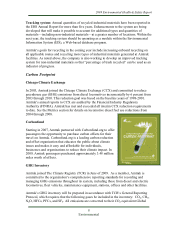Amtrak 2009 Annual Report Download - page 20
Download and view the complete annual report
Please find page 20 of the 2009 Amtrak annual report below. You can navigate through the pages in the report by either clicking on the pages listed below, or by using the keyword search tool below to find specific information within the annual report.
2009 Environmental Health & Safety Report
18
Public Health
The new Amtrak/Copesan program requirements are a combination of several pest
management procedures such as inspections, residual application and baiting for rodents
and insects in non-public areas of all rail cars. These pest management inspections and
services are provided during a 92-day preventive maintenance cycle for each passenger rail
car.
Additionally, due to the emergence of bed bugs and other biting insects in the lodging and
transportation industry, the Amtrak management team and Copesan developed and
implemented proactive strategies for the inspection and treatment for biting insects, as well
as a protocol for preventive residual treatment designed to actively mitigate the risks
associated with these pests. Along with the strategies outlined, a pilot program was
implemented at the Los Angeles maintenance facility during the preventive maintenance on
transition dormitory sleeper cars. If successful, these services may be added at other
maintenance facilities.
Metrics
Compliance Inspections
Once again in FY ‘09, the EHS Department tightened its goal for percentage of inspections
rated “satisfactory” for all food car, commissary, and watering point inspections conducted
by the Public Health group, raising the target from 89 percent to 90 percent. And once
again the Public Health team was pleased to report that Amtrak exceeded its goal by
completing the year at 91 percent, which in turn makes that the new goal for FY ‘10.
As indicated in the chart below, the results of all three types of Systemwide Compliance
Inspections met or exceeded goals. Although the Food Car Inspections met goal at 90%,
the Public Health group worked closely with the various departments to zero in on trends of
the leading causes of violations on food cars, which included inadequate refrigeration/
freezer temperature and onboard service crews not properly documenting temperature
monitoring forms. These issues were addressed during monthly Division Sanitation Task
Force teleconferences and the goal was met.
Systemwide
Inspections
Total Satisfactory Conditional % Satisfactory
Food Cars 708 640 68 90%
Commissaries 53 51 2 96%
Water Points 69 66 3 96%
Composite 830 757 73 91%
























